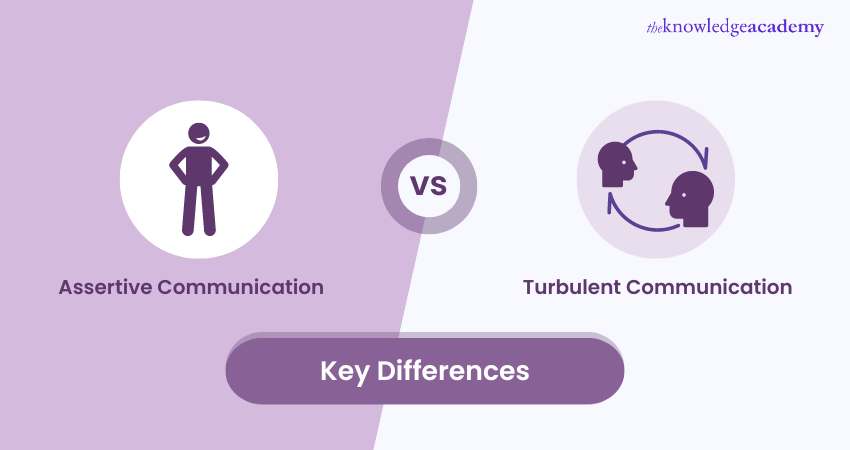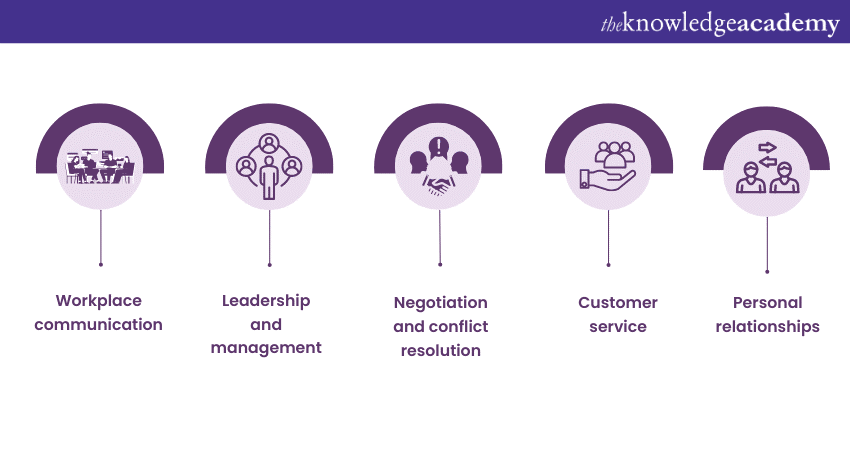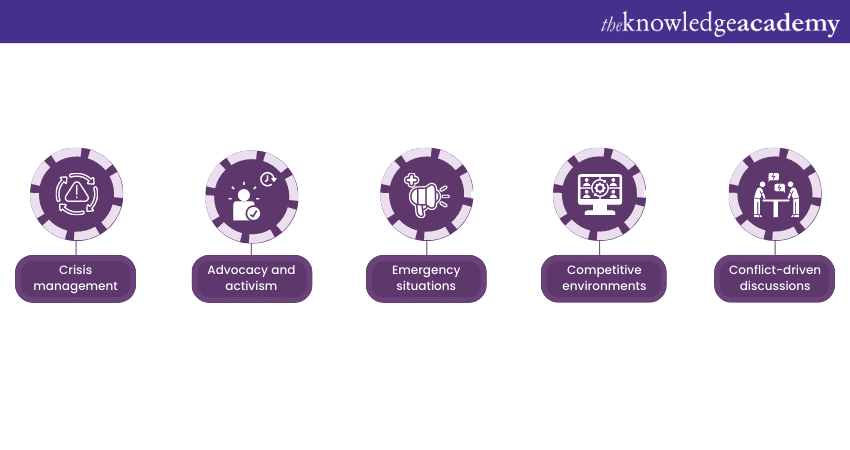We may not have the course you’re looking for. If you enquire or give us a call on 01344203999 and speak to our training experts, we may still be able to help with your training requirements.
Training Outcomes Within Your Budget!
We ensure quality, budget-alignment, and timely delivery by our expert instructors.

Assertive vs Turbulent communications are the two trending ways to interact with your colleagues and stakeholders. These styles greatly impact interpersonal relationship dynamics and reshape the ways of conveying their thoughts, emotions, and ideas. They serve as the foundation for building relationships, resolving conflicts, and fostering understanding.
To this end, understanding their key differences can significantly impact how humans navigate conversations and handle disagreements. But how do Assertive vs Turbulent Communication styles differ from one another?
Read this blog and dive into comprehending the difference between Assertive vs. Turbulent approaches. Moreover, you will also learn about their modern applications and how they impact your communication style.
Table of Contents
1) What is an Assertive Personality?
2) What is a Turbulent Personality?
3) Assertive versus Turbulent Communication: Key Differences
4) The Modern Applications of Assertive and Turbulent Communication
5) Conclusion
What is an Assertive Personality?
An assertive personality is characterised by confidence in expressing thoughts, feelings, and needs clearly and respectfully. These individuals advocate for themselves without being aggressive or passive, maintain healthy boundaries, make decisions, and engage constructively with others.
Assertive communication is a powerful method of expressing oneself while respecting others' rights and boundaries. It fosters understanding, encourages open dialogue, and promotes healthy relationships. Assertive communicators are clear, concise, and actively listen, ensuring their message is conveyed respectfully and purposefully.
What is a Turbulent Personality?
Turbulent individuals are passionate, perfectionistic, and driven by a desire to improve. They are highly self-aware and sensitive to stress, using it as a motivator to overcome challenges. However, their perfectionism may lead to self-doubt and comparisons with others, sometimes resulting in frustration or self-criticism. In communication, they may express concern or overanalyse situations but are not inherently hostile or aggressive.
Turbulent communication, in contrast, is aggressive and antagonistic, using hostile language and tactics like intimidation. This communication style creates tension, damages relationships, and negatively impacts emotional well-being. It involves verbal aggression, dismissing others' perspectives, and relying on blame and criticism, leading to escalated conflicts and strained interactions.
Master business communication attitudes and emotional skills by signing up for our Nonverbal Communication Training now!
Assertive versus Turbulent Communication: Key Differences
The assertive and turbulent communication may seem similar, they carry significant distinctions. Here are the key differences between Assertive vs Turbulent Communication:
|
Key Aspects |
Assertive Communication |
Turbulent Communication |
|
Style |
Clear, direct, and respectful expression of thoughts and feelings. |
Aggressive and confrontational communication style. |
|
Emotional expression |
An open and honest expression of emotions while considering others' feelings. |
Emotional outbursts, anger, and blame without regard for others' emotions. |
|
Conflict resolution |
Emphasises Active Listening, empathy, and finding mutually beneficial solutions. |
Escalates conflicts, hinders resolution, and damages relationships. |
|
Relationship building |
Fosters trust, respect, and understanding contribute to positive relationships. |
Strains relationships and hampers effective communication due to its aggressive nature. |
|
Tone |
Respectful and considerate. |
Demeaning, insulting, and aggressive. |
|
Non-verbal cues |
Maintains appropriate body language and tone of voice. |
May exhibit aggressive body language and intimidating gestures. |
|
Focus |
Problem-solving and collaboration. |
Blaming and criticism. |
|
Boundaries |
Respects personal boundaries and set your own boundaries clearly. |
Disregards others' boundaries and personal space. |
|
Listening |
Communicators actively listen, engage, and validate others' perspectives. |
Communicators dismiss or invalidate others' perspectives and lack empathy. |
|
Outcome |
Positive and constructive interactions enhance relationships. |
Negative and destructive interactions, damages relationships. |
|
Emotional impact |
Enhances self-esteem and reduces stress and anxiety. |
Creates stress, anxiety, and hostility. |
|
Goal |
Effective communication, mutual understanding, and cooperation. |
Control, dominance, and self-assertion. |
|
Long-term effect |
Improves communication dynamics and fosters healthier relationships. |
Erodes trust, strains relationships, and impedes personal growth. |
|
Conflict handling |
Seeks resolutions through open dialogue and compromise. |
Escalates conflicts, avoids resolutions, and perpetuates negativity. |
Seamlessly handle disputes and resolve conflict in an organisation by signing up for our Conflict Resolution and Negotiation for Change Training now!
The Modern applications of Assertive and Turbulent Communication styles
There are numerous modern applications of assertive and turbulent communications. Below, we have described those in detail:
Assertive Communication
Here is a list of the applications of Assertive Communication:

a) Workplace Communication: Assertive Communication is vital in the workplace for individuals to express their ideas, concerns, and boundaries effectively. Additionally, it promotes teamwork, collaboration, and a positive work environment.
b) Leadership and Management: Leaders and managers must be able to provide clear directions, delegate tasks, and address performance issues. Assertive communication fosters mutual respect, encourages open dialogue, and empowers team productivity.
c) Negotiation and Conflict Resolution: Assertive Communication is instrumental in negotiating to arrive at mutually beneficial outcomes and resolving conflicts constructively. It allows individuals to express their needs while considering the interests of others, leading to solutions that benefit everyone.
d) Customer Service: This communication style helps customer service representatives effectively address customer queries, concerns, and complaints. Additionally, it enables them to remain empathetic, listen actively, and provide satisfactory solutions for customer satisfaction and loyalty.
e) Personal Relationships: Assertive Communication is valuable in personal relationships, enabling individuals to express their feelings, set boundaries, and respectfully resolve conflicts. In addition, it promotes healthy communication, strengthened emotional connections, and long-lasting relationships.
Turbulent Communication
There are multiple applications for turbulent communication. Here is the comprehensive list of this critical communicational mode.

a) Crisis Management: Turbulent Communication may find application in crisis management situations where quick decision-making and assertiveness are required. However, it must be applied with caution to avoid further escalation or harm.
b) Advocacy and Activism: This communication style may be utilised by activists or advocates to draw focus on pressing social or political issues. It can be a forceful way to galvanise attention to injustices and demand change.
Emergency Situations: This communication style may be utilised by activists or advocates to draw focus on pressing social or political issues. It can be a forceful way to galvanise attention to injustices and demand change.
c) Competitive Environments: Highly competitive environments like sports or business negotiations may adopt Turbulent Communication to assert dominance. This can be particularly implemented to intimidate opponents or attain a competitive advantage. However, it should be used sparingly and with caution due to its impact on relationships.
d) Conflict-Driven Discussions: Turbulent Communication may be used as a last resort to disrupt conventional power structures and compel necessary discussions. It should be used when conflicts are severely ingrained, and the resolution seems problematical. However, it should be approached with caution and a focus on finding constructive solutions.
Learn to express yourself confidently and enhance your career prospects by signing up for our Assertive Skills Training now!
Conclusion
You cannot neglect the profound differences between assertive and turbulent communication styles. While Assertive Communication focuses on fostering understanding, collaboration, and healthy relationships, Turbulent Communication relies on breeding hostility, conflicts, and damaged connections. So, making an informed selection decision between the two styles is highly important to establish positive dynamics and accomplish your goals. Remember, your communication style can either build bridges or burn them, shaping the world around you. So, choose wisely!
Achieve proficiency in communication types and leadership styles by signing up for our Executive Communication Training now!
Frequently Asked Questions

Can Individuals Exhibit Both Assertive and Turbulent Traits Simultaneously?

The three steps to be followed to attain assertive communication are being analytical, assessing the other person's communication, and making clear and direct statements.

The Knowledge Academy takes global learning to new heights, offering over 30,000 online courses across 490+ locations in 220 countries. This expansive reach ensures accessibility and convenience for learners worldwide.
Alongside our diverse Online Course Catalogue, encompassing 17 major categories, we go the extra mile by providing a plethora of free educational Online Resources like News updates, Blogs, videos, webinars, and interview questions. Tailoring learning experiences further, professionals can maximise value with customisable Course Bundles of TKA.

The Knowledge Academy’s Knowledge Pass, a prepaid voucher, adds another layer of flexibility, allowing course bookings over a 12-month period. Join us on a journey where education knows no bounds.

The Knowledge Academy offers various Communication Skills Courses, including Public Speaking Training, Negotiation Skills Training, and Conflict Resolution and Negotiation for Change Training. These courses cater to different skill levels, providing comprehensive insights into Operations Management.
Our Business Skills Blogs cover a range of topics related to Communication Skills, offering valuable resources, best practices, and industry insights. Whether you are a beginner or looking to advance your Communication skills, The Knowledge Academy's diverse courses and informative blogs have got you covered
Upcoming Business Skills Resources Batches & Dates
Date
 Public Speaking Course
Public Speaking Course
Fri 28th Feb 2025
Fri 11th Apr 2025
Fri 27th Jun 2025
Fri 22nd Aug 2025
Fri 24th Oct 2025
Fri 28th Nov 2025







 Top Rated Course
Top Rated Course



 If you wish to make any changes to your course, please
If you wish to make any changes to your course, please


